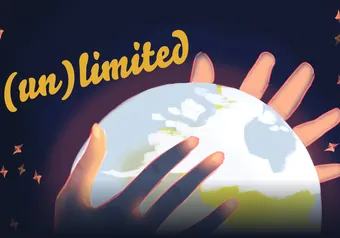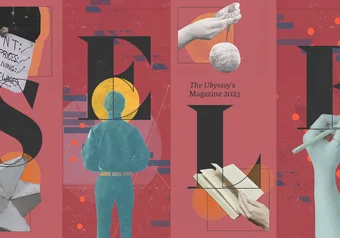A group sits bundled by the fire, shoulders touching and voices low, as they enjoy the comfort of companionship.
This familiar scene could represent a couple of college friends roasting marshmallows by an open fire as they listen to the new Drake album just as easily as it could portray a family of weary Paleolithic humans spending a few quiet moments together.
As humans evolved, so did our communities.
But we haven’t changed much.
Natural selection is an evolutionary mechanism describing population-wide change which happens as certain traits offer a non-random advantage for reproductive success. This results in beneficial traits being inherited — and becoming more common — in future generations. Our social affinities may be an example of this; according to a 2021 Frontiers in Ecology and Evolution research article, sociality paved the way for brain development, both in size and organization.
From the marked jump in brain size over the past several million years to the more subtle refinements as early as 3,000 years ago, sociality has remained an important driver — for modern humans as much as our stone age ancestors.
“Our brains … don’t function any differently than they did thousands of years ago,” said Dr. Mark Schaller, a psychology professor at UBC. “We are modern people, but still living with a stone age mind.”
And these “stone age minds,” studies suggest, are hardwired for social connection. In the midst of a pandemic, students are left to endure the implications of a brain that evolved to be social — perfectly designed for anything but these unprecedented times.
Let’s start from the beginning
Humanity’s earliest communities were valuable for survival. According to a 2017 Scientific Reports article on modern hunter-gatherer societies, mothers with more indirect social ties — more friends of friends relationships — tended to have better offspring survival.
As primates, we evolved from a lineage of social animals. Bonobos and chimpanzees, our closest living relatives, are social creatures as well.
A 2020 Frontiers in Psychology article summarized various ways human sociality — and by extension community — provided an advantage over our closest primate relatives.
The authors argued that a cooperativity-oriented lifestyle that incorporated tasks like toolmaking, hunting, foraging and taking care of other people’s children made early humans “uniquely codependent and other-regarding compared to other great apes.”
Emotional control soon became a beneficial trait for early humans, providing support for its modern day influence. With time, pro-social behaviours laid the foundations of kinship and cooperation that our current societies rely on.
Fast forward 300,000 years
Despite the contrast between modern society and our stone-age brains, humans have been quite successful. The skills that were needed then, like problem-solving and cooperation, are skills we still need today — just presenting in different ways. Instead of discovering fire, we are faced with questions of food sustainability, systemic discrimination and space travel.
“The reason our cognition is so powerful is because it’s an adaptation to living in social groups,” said Dr. Edward Slingerland, a professor of philosophy at UBC who has done research in evolutionary psychology.
As described in a 2012 Frontiers in Physiology mini-review and a 2016 review written by anthropologist Dr. Robin Dunbar, the social brain hypothesis is based on the scientific understanding that our brains grew as a result of living in complex social groups. According to Dunbar, “unusually complex” primate societies may explain the need for “unusually large brains” to manage the social hierarchies.
But to understand the relationship between brain size and social behaviour, researchers needed to first establish the “cognitive load” that is required, according to the mini-review. Figuring out exactly how neurons are arranged for a particular behaviour, as well as how many there are and the mechanisms employed to actually process information, is much easier theorized than done.
According to Dunbar, the ability to mentalize — an “archetypal form of social cognition” — mediates this relationship between brain size and social group size in humans.
Mentalizing, also known as theory of mind, is the social-cognitive ability that involves recognizing other people can have different emotions and mental states than our own. Singerland outlined the theory of mind as one way our intuition presents itself.
Living in communities has also increased the intuition that we use in day-to-day life. Schaller noted that a social community has an expectation of cooperation, and in turn reciprocity, and our brain evolved to identify the people who may cheat us. We use this intuition in situations ranging from group projects to romantic relationships.
We helped ourselves along the way
To highlight the extent of human cooperativity, Slingerland referenced an airplane seat analogy in Dr. Sarah Blaffer Hrdy’s book Mothers and Others: The Evolutionary Origins of Mutual Understanding. While human beings are capable of remaining in their airplane seat with their seatbelt on for long periods of time, chimpanzees would tear each other apart, creating a massacre in a metal tube, as described by Blaffer Hrdy.
“We cooperate on a scale that goes way beyond our primate relatives,” Slingerland said.
Indeed, cooperation presents a benefit for peaceful coexistence in the complex groups that humans live in. Social factors, like culture, also play a critical role: though cooperative behaviour may not be advantageous for the individual, it is beneficial for the group, as demonstrated in a Nature Communications study by Arizona State University researchers, Dr. Carla Handley and Dr. Sarah Mathew, which tested the cultural group selection theory.
By this theory, “culturally different” groups compete against others, thereby encouraging the spread of characteristics – like cooperativity – that give groups a “competitive edge,” according to a press release on Mathew and Handley’s study.
“People have the intuition that being cultural helps us cooperate,” said Mathew in an interview with Arizona State University. “What we are showing is that culture allows groups to be different, and therefore to compete. It is this group competition — ironically — that sculpted our cooperativity.”
Another theory emphasizing the importance of the group is the cultural brain hypothesis which, Schaller explained, expands on the social brain hypothesis.
It suggests that living in groups allows for the cultural accumulation of knowledge is “probably more important” than simply living in these large groups, according to Schaller.
The value of culture as a driver for the selection of social traits has been hotly discussed, but studies like that of Handley and Mathew’s provide much needed evidence to support these theories. In their study, Handley and Mathew asserted that culture-driven selection could shed light on some of the mysteries of our social brains.
“[Group-level selection on cultural variation] acting over human evolutionary history may explain why we cooperate readily with unrelated and unfamiliar individuals,” they wrote, “and why humans’ unprecedented cooperative flexibility is nevertheless culturally [limited].”
A product of all that came before us
Community is often used to describe a society, but it can also be used for common interests. We seek out these smaller, common-interest communities — anything from Twitch streams to book clubs.
A preference for more limited social groups may be explained by Dunbar’s number. Connected to the social brain hypothesis, Dunbar argued that 150 is the maximum number of stable relationships that humans can sustain at a given time. It’s limited by the amount of raw brainpower we have, which is linked to brain size.
150 was not an arbitrary number for Dunbar.
“For most of our evolutionary history, we lived in relatively small hunter-gatherer bands [where] we would interact with 50 to 150 people on a regular basis,” said Slingerland.
Online connections, it appears, have not been able to transcend the limitation imposed by Dunbar’s number.
Ever keen to challenge his opposers, Dunbar published a study in 2016 discussing whether the digital age has confounded his three-digit dogma. Facebook friends do not equate to face-to-face relationships, with Dunbar writing that “there is a cognitive constraint on the size of social networks that even the communication advantages of online media are unable to overcome.”
As the brain appears to have limits that persist in an ever-changing landscape of evolving communities, new questions arise for researchers like Dunbar, Mathew and Handley. Community is more than skin deep — it’s in our bones, in the wiring of our brains and the relationships we crave.
Millions of years ago, early humans learned to co-exist and cooperate; sitting together by a smouldering flame, exchanging stories, sharing passions and finding community.
Today, these adaptive benefits suggest an intrinsic value in being together — now more than ever.
Share this article
First online






